Reports
Overview
On the Reports page, you can view Standard and Custom reports and sort the data on different factors. You can also search, filter, and export the reports, as described below.
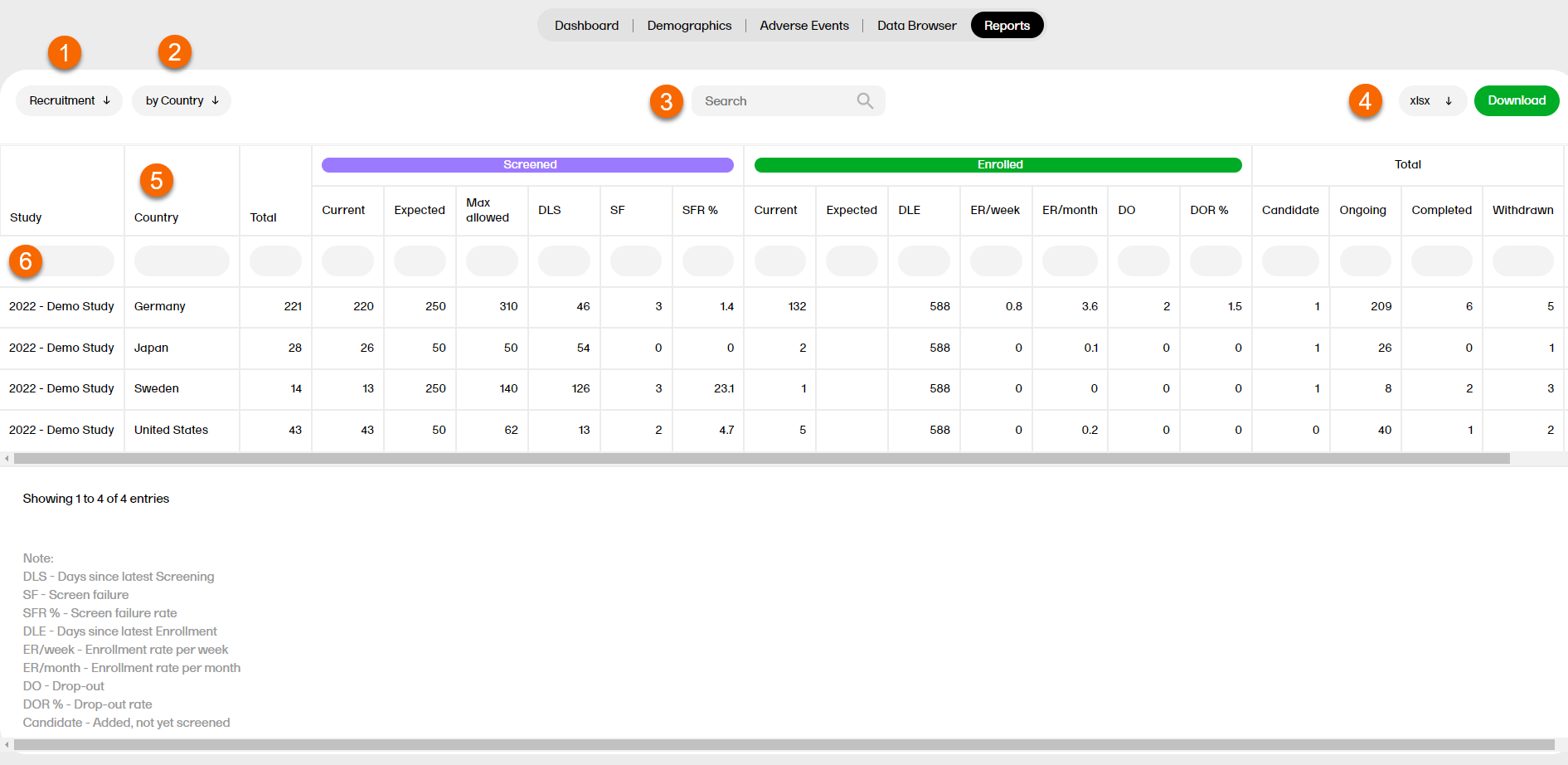
1. Select a report in the dropdown list.
2. Click to select the sorting, where applicable: by country/site/event/subject/form/item.
3. Search the entire table for matches containing the word.
4. Select a format to download: xlsx / csv / xpt. For more information, see Downloading reports.
5. Click a column header to sort the data in ascending order. Click again to sort in descending order.
6. Click any field and set a range to filter your data. Click the x symbol to reset the filter.
Standard reports
The reports based on standard data are described in the following sections.
TIP! Many of the standard reports can now be downloaded and customized for use as custom reports. To access the report scripts, please go to the example-standard-reports repository on Viedoc's GitHub.
General rules and definitions
The following section describes general rules and definitions applicable to all reports.
- Deleted subjects are not counted or included in the reports.
- General hidden forms are counted and displayed in the report
- Forms that are hidden for certain roles are not counted or displayed in reports they generate
- Forms are considered triggered when they are initiated or pending.
- Forms are considered pending when they are uninitiated in initiated events.
Note! This applies to all event types. - Forms are considered initiated when they have at least one item in the form populated.
- Subject Sequence Number is included in all standard reports and sub-reports
alongside Subject ID, allowing subjects to be uniquely identified across reports.
Recruitment
The Recruitment report shows recruitment data with details on the subject status.
For more information on the Recruitment report, please go to: Recruitment

Review status
The Review status report shows the review status (Clinical, Data, Source Data Verification (SDV), Sign, and Lock).
For more information on the Review status report, please go to: Review status

Missing data
The Missing data report shows the missing items.
For more information on the Missing data report, please go to: Missing data

Query reports
There are four query reports available (manual and validation queries, manual queries, validation queries, pre-queries) that show the detailed query data at different levels across the studies.
For more information on Query reports, please go to: Query reports

Pending forms
The Pending forms report shows the pending forms*.
For more information on the Pending forms report, please go to: Pending forms
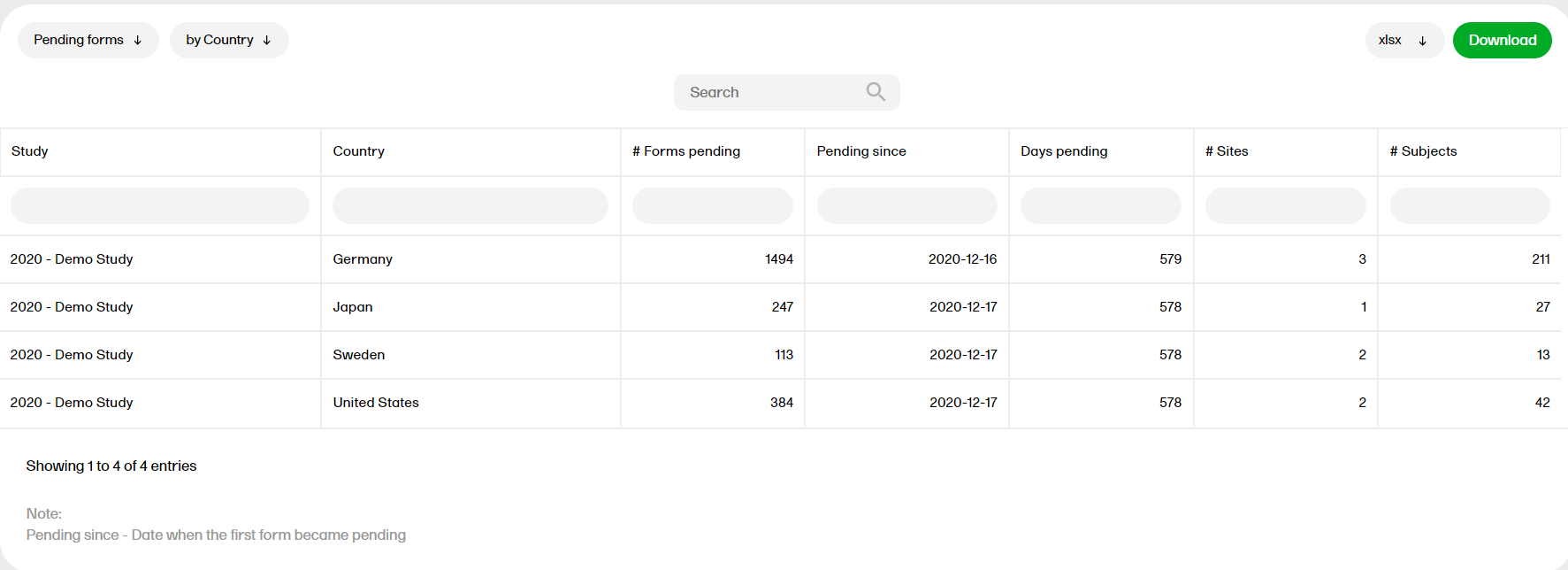
*Forms are considered pending when they are uninitiated in initiated events. This applies to all types of events, including subject-initiated events. For repeating forms, if the first instance of the form is uninitiated, the form is considered pending. Resetting a form results in that form being pending.
Data entry cycle time
The Data entry cycle time report shows how long time it takes for the sites to enter form data.
For more information on the Data entry cycle time report, please go to: Data entry cycle time

Medical coding
The Medical coding report shows the coded data in the study. You can select reports for the dictionaries WHODrug, MedDRA, MedDRA_J, ATC without DDD, and IDF.
For more information on the Medical coding report, please go to: Medical coding

Disposition
The Disposition report shows overviews of the current disposition status of the subjects across the study.
For more information on the Disposition report, please go to: Disposition
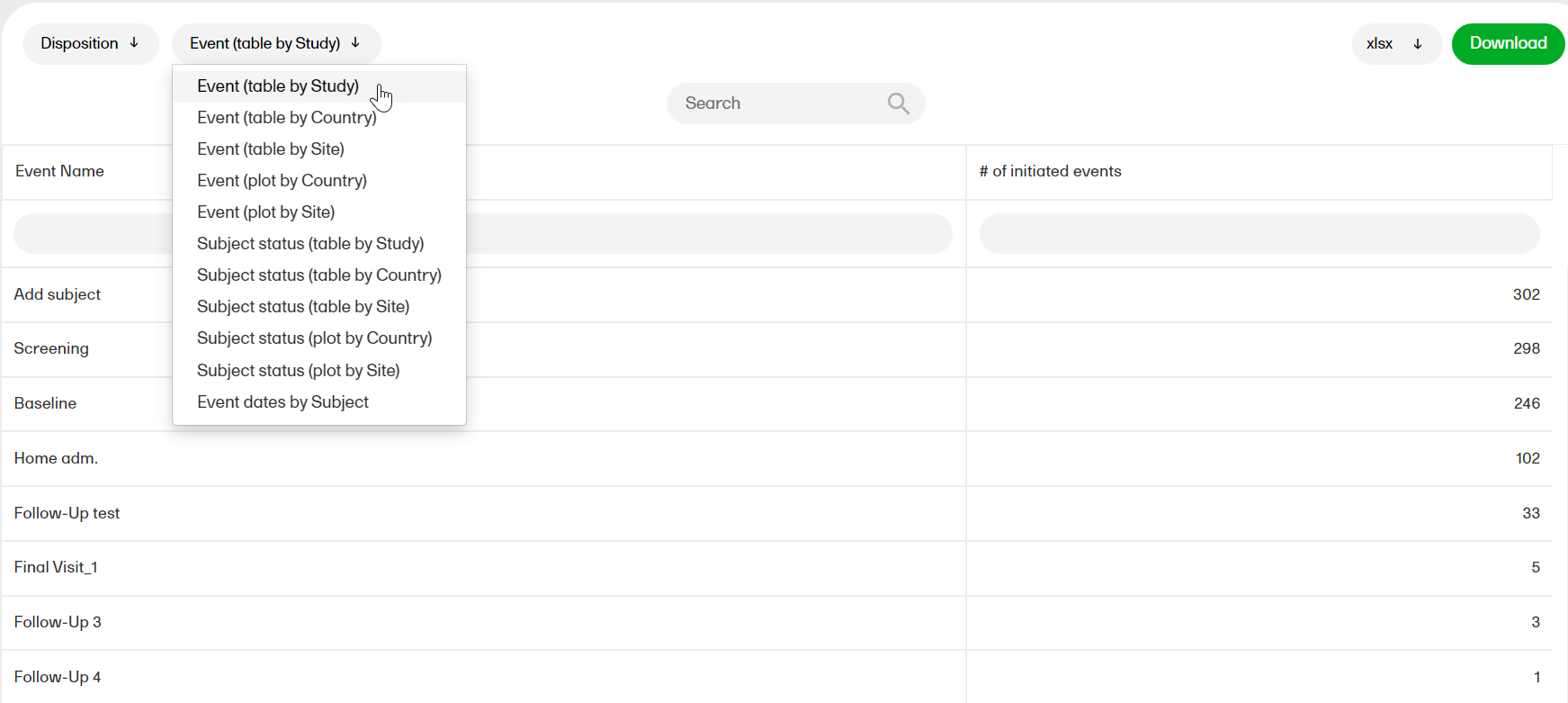
Demographics summary
The Demographics summary report shows a table and a pie chart with the variables from the Demographics page.
For more information on the Demographics summary report, please go to: Demographics summary
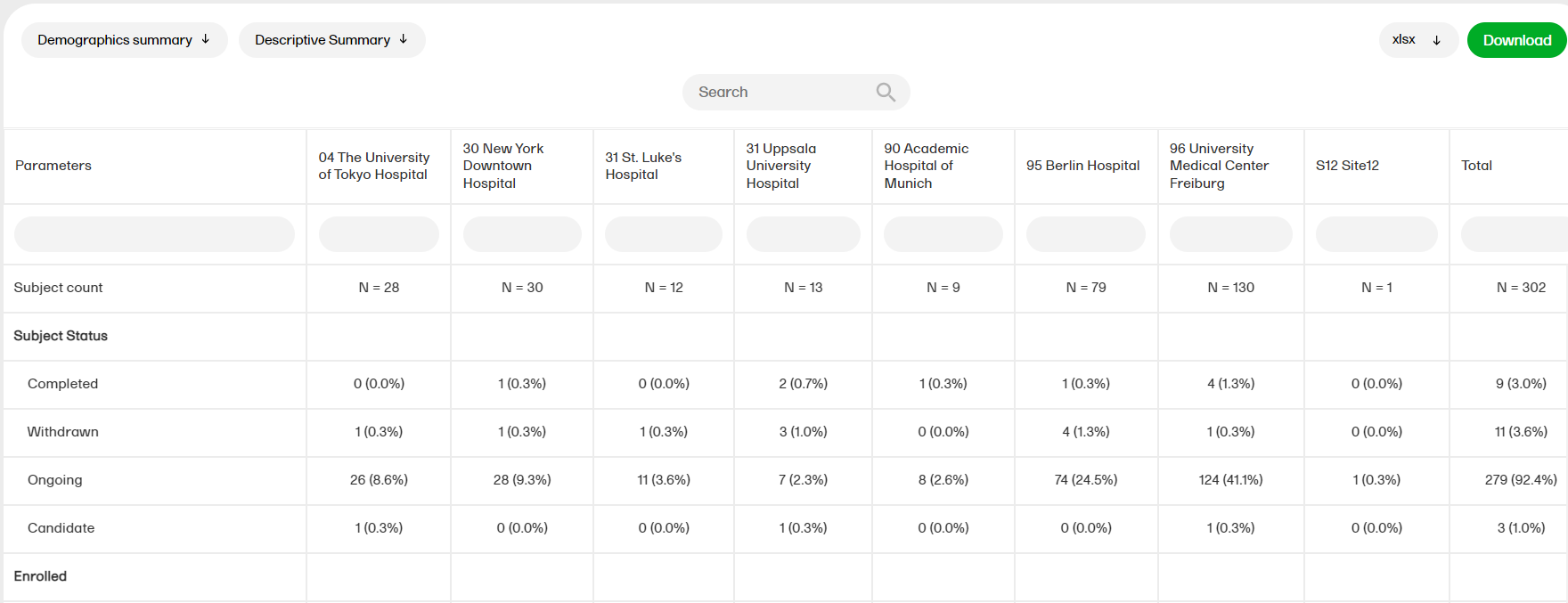
The pie charts can be downloaded as a PNG file by clicking on the camera icon.
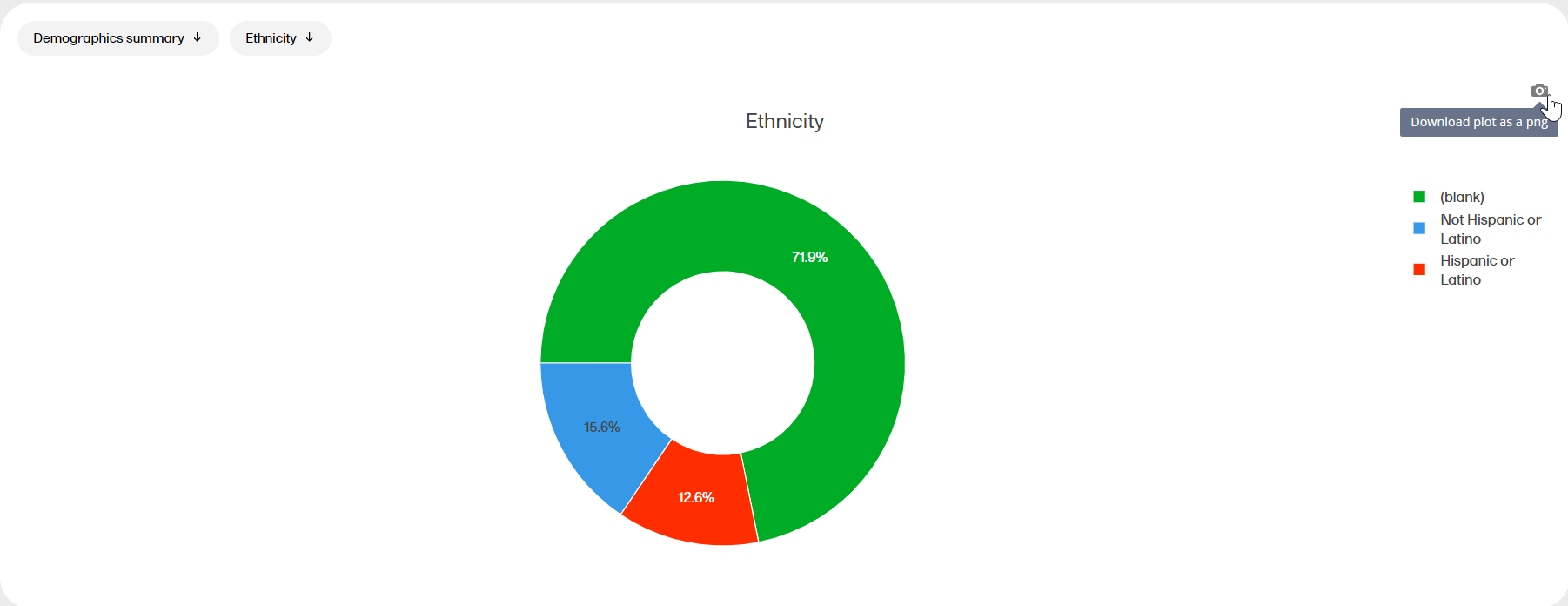
Audit trail review
The Audit trail review report shows divergences to the normal data entry pattern as well as the general performance. You can choose between two tabs: Overview and Change over time. The filter feature is common between these two tabs.
Overview
The following settings can be done in the Overview tab:
- Select the Countries, Sites, Events, Forms to filter the audit trail report, all options are selected by default. Click All to select all options and None to deselect all. Use the search field to search for any value.
- Select to Include or Exclude (default) system updates.
- Click Apply to save the filters.
- Select to present the reports by Plot type (Count/Rate) and Rate type (Subject/Item):
- If Plot type Count is selected, the number of data operations is shown in each bar. You can switch between showing only the Inserts, Updates, or Both using the Count type radio control.
- If Plot type Rate and Rate type Subject are selected, then
o by Country/by Site plots display Updates per Subject
o by Event plot displays Updates per Subject Event
o by Form plot displays Updates per Subject Form - If Plot type Rate and Rate type Item are selected, then the all the plots display Updates per Item.
- Select the Sort type (Descending/Alphabetical) to sort the bars either based on the descending order of the bar height, or by alphabetical order of the x-axis labels.

You can now see the data operations by country, site, event, and form. You can also see the data operations by item (top 20), which only appears if plot type Count is selected.
Terms
Insert: For the grouping Subject,Event,Activity,Form,Item the first entry is called 'Insert'.
Update: For the same grouping the other entries are called 'Update'.
System Updates: Records that are of OperationType 'Update' and the EditBy is 'System(0)' are considered as System Updates
Rate by Item is number of Updates/ number of Inserts (per item, subject event etc based on plot viewing) rounded to the 2nd decimal.
Rate by Subject is number of Updates (per item, subject, event etc based on plot viewing)/ count of Subjects rounded to the 2nd decimal.
Overview and Plot terms
Rate by Item: The Line value is calculated as sum of number of Updates / sum of number of Inserts at a study level rounded to the 2nd decimal.
Rate by Subject : The line value is calculated as sum of number of Updates/ count of total subjects in the study rounded to the 2nd decimal.
Change over time
The following settings can be done on the Change over time tab:
- Select the Countries, Sites, Events, Forms to filter the audit trail report. All options are selected by default. Click All to select all options and None to deselect all. Use the search field to search for any value.
- Select to Include or Exclude (default) system updates.
- Click Apply to save the filters.
- Accumulate type can be used to define the timepoints interval at which the data should be accumulated in the below two plots.
Number of data operations plot
The Number of data operations plot displays a timeline across the study start until now, rendering the number of Inserts/Updates accumulated between each time point.

Cumulative number of data operations
The Cumulative number of data operations plot displays a timeline across the study start until now, rendering the cumulative number of Inserts or Updates done since the start of study up until that time point.

Additional features common to both plots:
- A smaller plot is provided below the main plot which be used to zoom and pan the main plot.
- By default, the plots are zoomed to the last 12 timepoints.
- You can use the buttons at the top of the plot to zoom to different period windows:
- 3 mo - 3 months
- 6 mo - 6 months
- 1 yr - 1 year
- YTD - Year-to-day - Start from January of current year and end with the latest available timepoint
- All - Zoom out full to show the complete timeline
Key risk indicator
The Key risk indicator (KRI) report gives you a quick overview of the key risk indicators per site. This report has three modes: Overview, by Site, and by Key risk indicator.
KRI calculations
The KRI values are based on calculations of:
- Site value
- Study mean (from Site value)
- Study deviation (from Site value)
Note! UTC is the standard in all calculations using date and time.
The following KRI values can be shown in the reports:
eCRF Data entry lag
Fetches the timelapse days for each form.
The Site value is the average number of timelapses across all forms in a site.
Note! The logic for the eCRF data entry lag calculation is as below:
- For each form, the difference between the form Initiated Date and the corresponding Event Date is calculated. This is considered as the lapsed time in days from the date of the visit to the date of form initiation.
- For example, if the Event Date is 01-Feb-2022, but the form was first saved on 10-Feb-2022, the timelapse would be 9 days.
- This information is also available as part of another standard report: Data Entry Cycle Time (by Form subreport - the last column is the Data Entry Cycle Time (days).
Overdue events per subject
Calculates the average number of overdue events for each subject.
The Site value is the average number of overdue events per subject for each site.
Overdue events is not shown if there are no overdue events in the study.
Pending forms per subject
Calculates the average number of pending forms for each subject.
The site value is the average number of pending forms per subject for each site.
Pending forms is not shown if there are no pending forms in the study.
Data changes per form
Fetches the number of updates for each form.
The Site value is the average number of updates across all forms in a site.
Note! System updates for the Data changes per form are not considered. Also, we only consider the updates but not the initial entry for the calculation.
Signature lag (in days)
Calculates the signature lag (in days) for each form. This is calculated as the number of days between the last edit date and time and signature date and time.
This is calculated only when there are signed forms in the study.
Note! The signature lag is calculated as below:
- Site average = average of signature lag across all forms in each site.
- Study average (from site level data).
- Study standard deviation (from site level data).
- Study median (from site level data).
AE - # of AE for each subject
This is calculated only if the AE module is defined.
Calculates the number of AE for each patient (one record per patient, with frequency of AE).
The Site value is the average number of AEs across all subjects in a site.
DOR% (drop out rate)
Calculates the drop out rate.
The Site value is the number of dropout subjects multiplied with 100 divided with the number of enrolled subjects.
For more information about the DOR% select this link.
SFR% (screening failure rate)
Calculates the screening failure rate.
The Site value is the number of screen failed subjects multiplied with 100 divided with the number of screened subjects.
Note! The screen failure rate is based on the following subject status definition in Viedoc Designer: ScreenFailed - if WithdrawnState = TRUE and EnrolledState != TRUE
Open Queries per subject
Calculates the number of queries for each subject.
The Site value is the average number of open queries across all subjects in a site (missing data and pre-queries are excluded).
Processed Queries per subject
Calculated as # resolved, closed, rejected or approved queries / # of Subjects
The Site value is the average number of resolved, closed, rejected or approved queries across all subjects in a site (missing data, pre-queries, and removed queries are excluded).
Rejected queries per subject
Calculates the number of rejected queries for each subject.
The Site value is the average number of queries with query status as rejected per subject for each site (pre-queries are excluded).
Rejected queries is not shown if there are no rejected queries in the study.
Time to query resolution (in days)
Calculated as sum of 'Open to Resolved Days'* or if missing, 'Open to Closed Days'*/'#Closed queries' (pre-queries and Removed queries are excluded).
The Site value is the average number of days is took between query raised day to query closed day across all queries in a site.
Confirmed missing per subject
Calculated as '#Confirmed missing items'* / '# of Subjects'
The Site value is the average number of confirmed missing data across all subjects in a site.
Unconfirmed missing per subject
The same as "Open Queries per subject" (but only for Unconfirmed missing).
The Site value is the average number of unconfirmed missing data across all subjects in a site.
The Study mean and Study deviation is the average and standard deviation of the Site value across all sites.
Overview
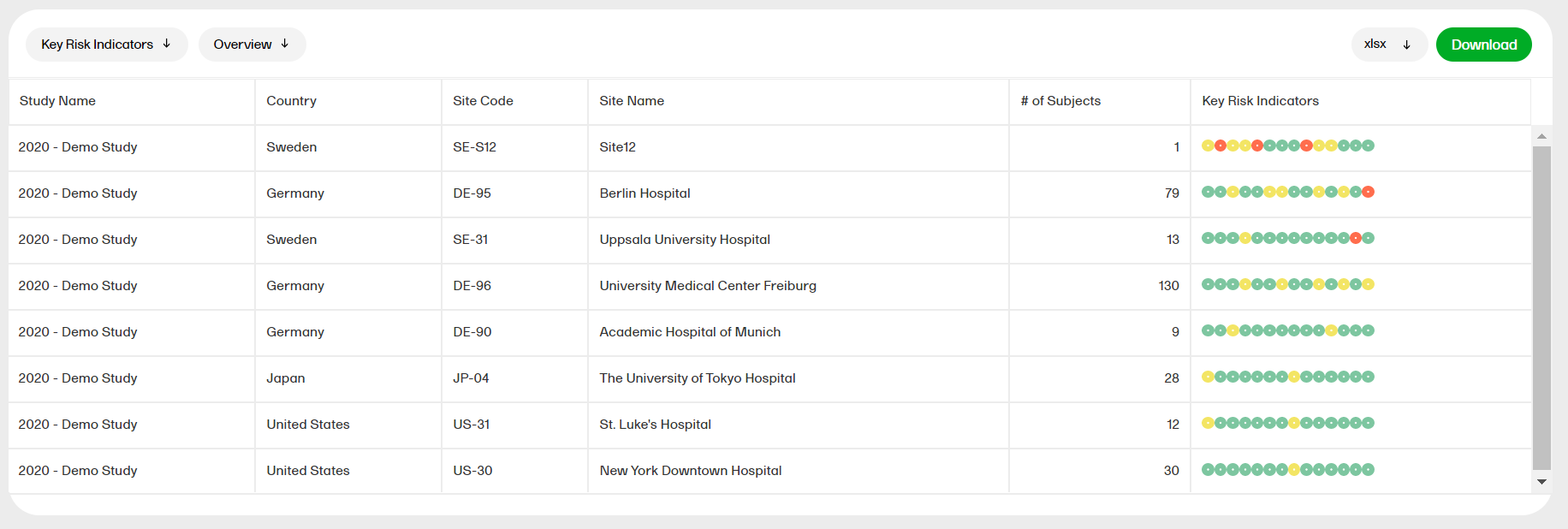
by Site
On the by Site tab, you can select a site to see a pie chart with the KRI status for that site.
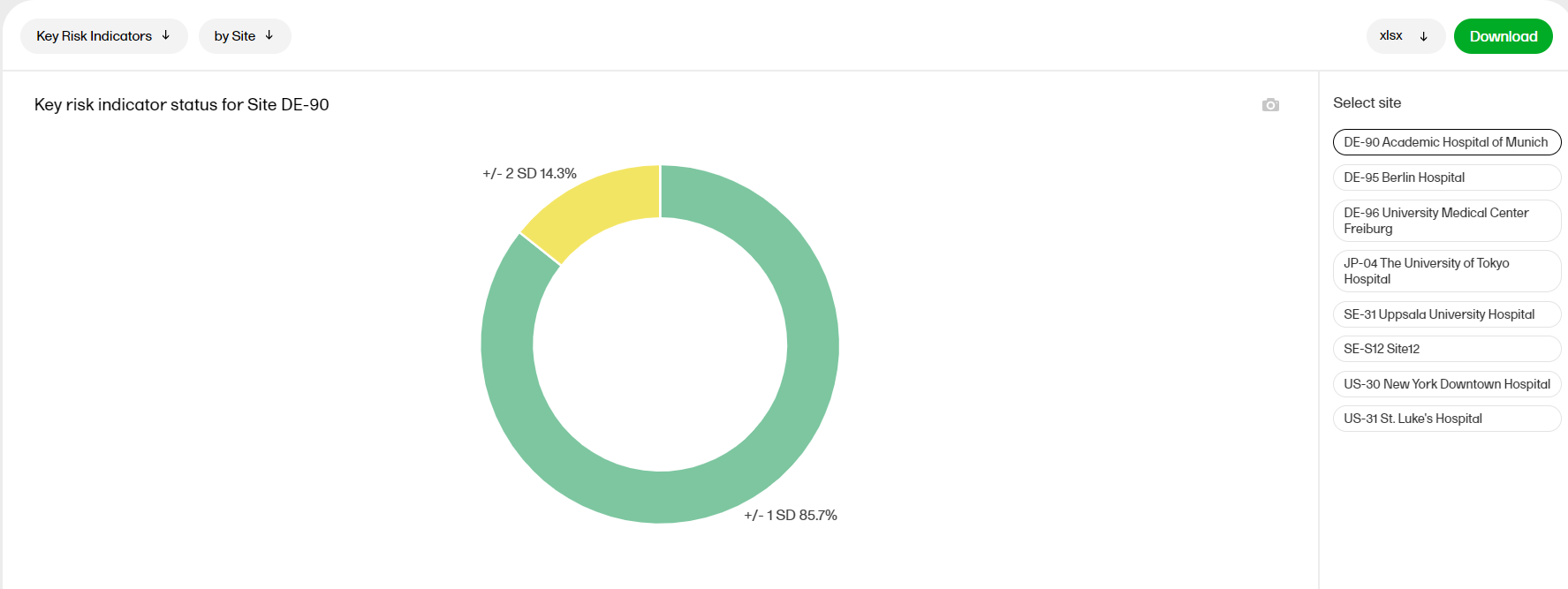
You can also see a table with more details about the KRI, showing the Study Name, Country, Site Code, Site Name, Key Risk Indicator, Site Value, Study Mean, Study Deviation, and Thresholds.
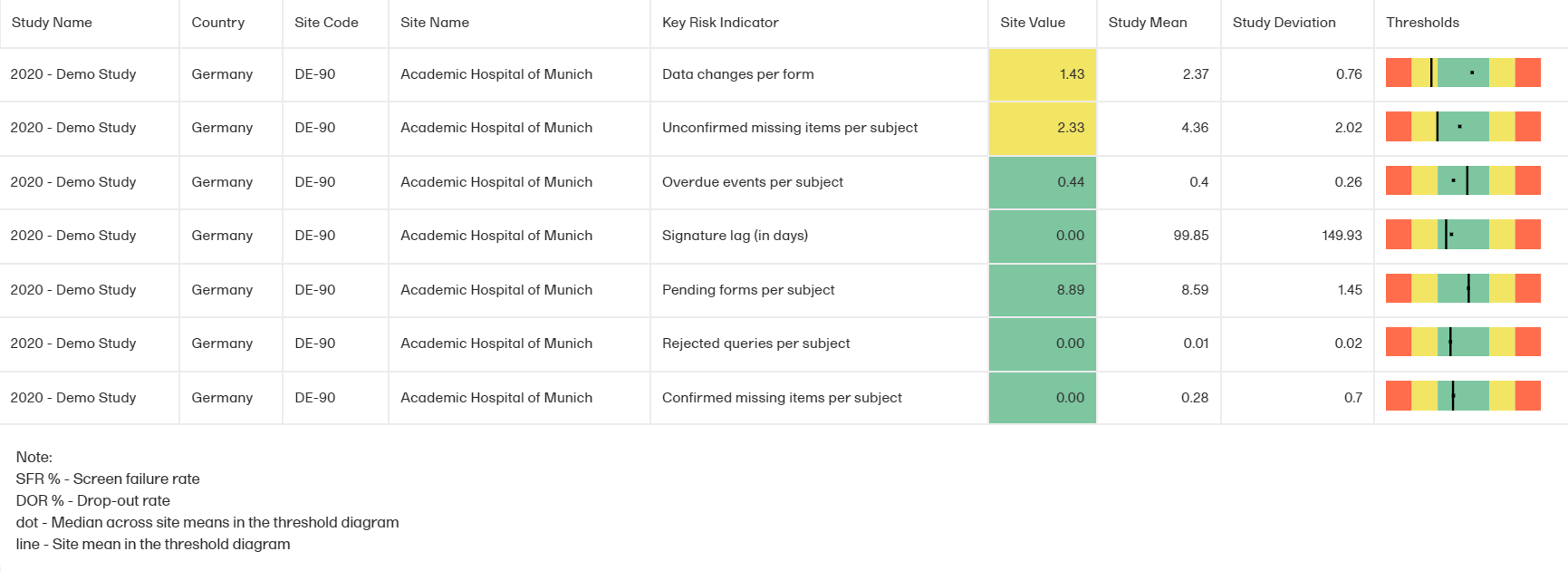
- Site Value - the calculated value of that particular indicator for that particular site
- Study Mean - the mean of the site values for that particular indicator
- Study Deviation - the standard deviation of the site values for that particular indicator
- Thresholds - the median of the site values (as a dot), site value (as a line) and the +/- 1-SD (as green), +/- 2-SDs (yellow), +/- 3-SDs (as red) as color bands.
SD = Standard deviation
by Key risk indicator
On the by Key risk indicator tab, you can select a key risk indicator to see a pie chart with the site status for that indicator.
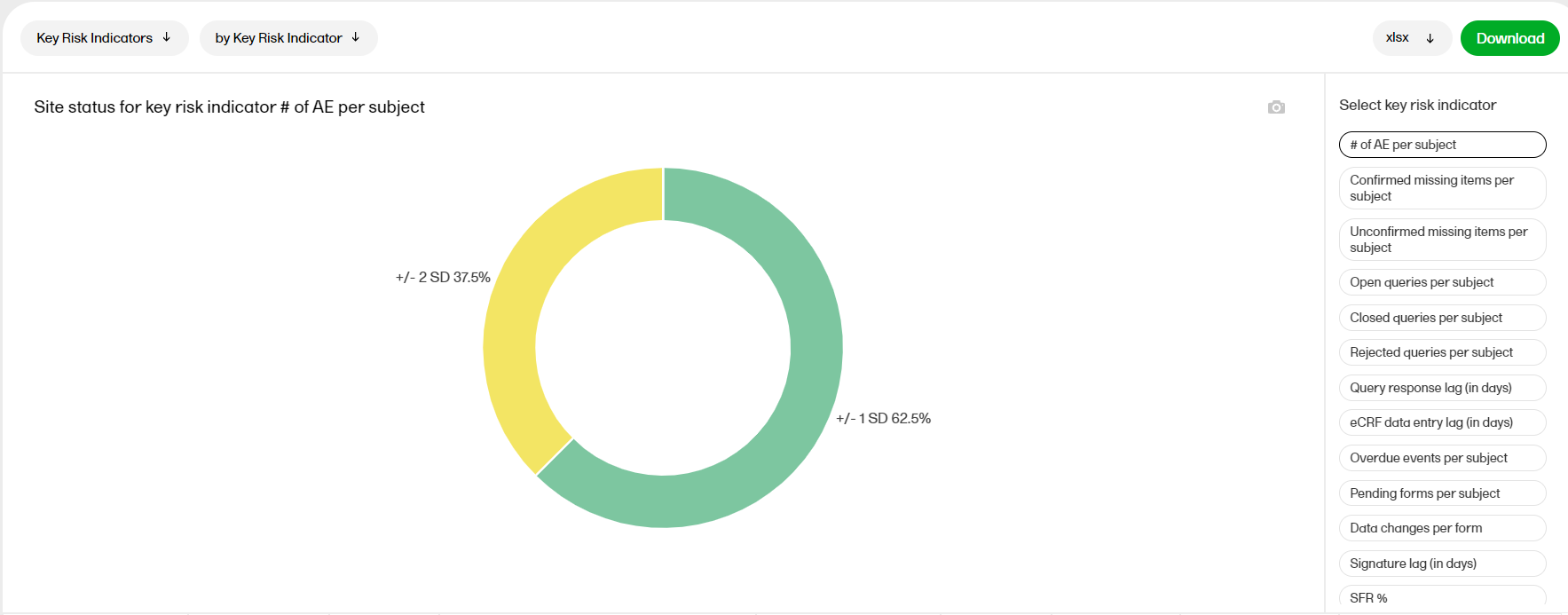
You can also see a table with more details about the site status, showing the Study Name, Country, Site Code, Site Name, Key Risk Indicator, Site Value, Study Mean, Study Deviation, and Thresholds.

- Site Value - the calculated value of that particular indicator for that particular site
- Study Mean - the mean of the site values for that particular indicator
- Study Deviation - the standard deviation of the site values for that particular indicator
- Thresholds - the median of the site values (as a dot), site value (as a line) and the +/- 1-SD (as green), +/- 2-SDs (yellow), +/- 3-SDs (as red) as color bands.
SD = Standard deviation
Overdue events
The Overdue events reports for the subreports ‘by Country', ‘by Site', ‘by Subject', ‘by Event’ shows the events that have the Proposed date and Event Window End Date set to a past date.
For more information about the Overdue events report, please select this link: Overdue events

Form status
The form status report gives an overview of the status of forms, for example, initiated, pending, completed, saved with issues, unsigned etc.
For more information on the Form status report, please select this link: Form status

PMS dashboard
The PMS dashboard report is available for Japanese PMS studies only and shows the following booklet statuses. You can sort the data to focus on the booklet status by site, subject, booklet, booklet history, or timelapse with the following columns showing, respectively:
by Site
- Study, Country, Site Code, Site Name
- The Cases columns show: # Pre-registered and # Registered subjects from the subject status.
- The Booklet columns show: Not Initiated, Initiated (with issues) - initiated records that have open queries, Ready to submit - Initiated records that have no open queries, Submitted, Received, Returned, Frozen.
This shows a site level summary of booklets status along with the number of pre-registered and registered cases. Booklet freeze progress as a percentage is shown as a bar plot.
by Subject
- Study, Country, Site Code, Site Name, Subject, Subject added date (from subjectAddedDate.rds), Subject completed date (from Subject Status)
- The Booklet columns show: Not Initiated, Initiated (with issues) - initiated records that have open queries, Ready to submit - Initiated records that have no open queries, Submitted, Received, Returned, Frozen.
This shows a subject-level summary of booklet status along with the Subject added date and Subject completed date. Booklet freeze progress as a percentage is shown as a bar plot.
by Booklet
- Study, Country, Site Code, Site Name, Subject
- The Booklet columns show: Booklet name, Booklet sequence #, Current status, Last activity date, Booklet start date, Booklet end date.
- The Queries columns show: # of raised queries, # of resolved queries, # of closed queries, # of rejected queries, # of approved queries, and # of removed queries.
This shows a booklet level summary of current booklet status and last activity date along with the number of open, resolved and closed queries.
by Booklet (history)
- Study, Country, Site sequence number, Site Code, Site Name, Subject sequence #, Subject, Subject added date, Booklet Name, Booklet sequence #, Booklet Status, Booklet Activity, Date & Time (UTC), User Name (ID)
This shows the Booklet status history- the user can filter for a specific date along with the Subject added date from the subjectAddedDate.rds file.
Note! This does not include "Not Initiated" records.
Timelapse
- Study, Country, Site Code, Site Name, Subject, Booklet Submitted Lapse Days
- The Queries columns show: Time to Resolution, Time to Approval
Time to Resolution shows the timelapse between the time raised to the time resolved or closed for each booklet status, summarized at Subject level.
Time to Approval shows the timelapse between the time resolved to the time approved OR rejected for each booklet status, summarized at Subject level.
Note! This is for subjects that have at least one booklet that has been Initiated and submitted. Also, the lapse in Resolved and Closed queries for a subject is obtained from Queries and displayed.
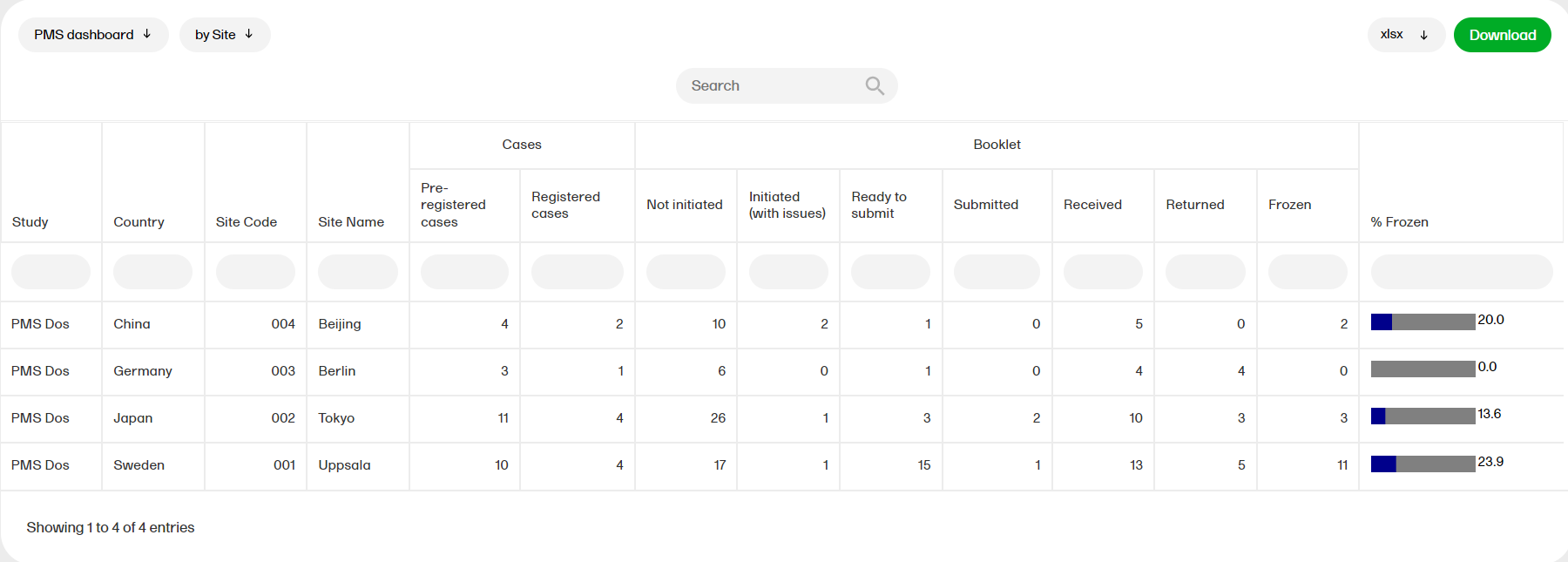
Custom reports
The reports showing up under Custom reports are tailor-made, study-specific ones. The Custom reports can be downloaded at all times, regardless of the user permission set for the role in Viedoc Designer.
Note! Some columns of the report may be empty, this is due to the visibility settings for your user role on CRF level.
The sort filters and columns showing the data depend on the report. Here you can see an example where the custom report DM Custom contains two filters, Demog1 and Demog2 (not visible in the image):

Downloading reports
You can download the reports in the following formats:
- XLSX
- CSV
- XPT
- XPTV8
- RDS
- XML - for custom reports, and only if the following criteria are met:
- The report output is specified as XML in the R script:
reportOutput <- list("xml" = new_xml_1) - The output file contains
Identifier:validationCheck <- "Identifier" - The report name contains the text string
E2B
For more information, see Custom reports. - The report output is specified as XML in the R script:
Note!
- Any sorting done in the report will not be reflected in the downloaded file.
- Downloading a file is available regardless of the user permission set for the role in Viedoc Designer.
The structure of the file name is as follows:
[STUDYNAME_REPORTNAME_DATE/TIMESTAMP.FORMAT]
If subreports are available, then the file name is:
[STUDYNAME_REPORTNAME_SUBREPORT_DATE/TIMESTAMP.FORMAT]
[DATE/TIMESTAMP] is in the following structure:
[YYYYMMDDHHMMSS], which is the date and time at which the data was downloaded from Viedoc (through the daily data sync).
Example of a file name: "DemoStudy2020_Review status_20200903220345.csv"
Download actions
There are two ways of downloading reports on the Reports page. You can either download a selected Standard report or download all the Standard reports.
To download data from a selected Standard report:
| 1. |
Select the specific report you want to download from the STANDARD REPORTS dropdown menu. In the example below, the Recruitment report is selected. 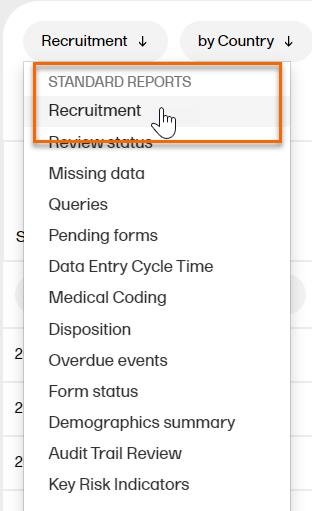
|
| 2. |
In Settings, select Download selected subreport in the dropdown menu. 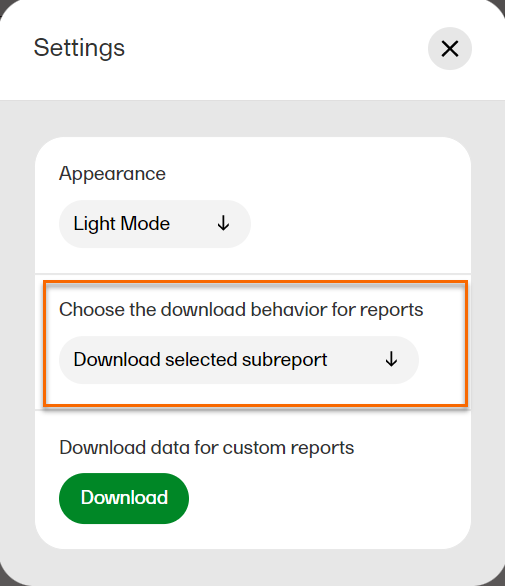
|
| 3. |
1. Select a format to download. 2. Click Download. 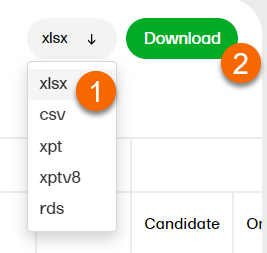
|
To download data from all Standard reports simultaneously:
| 1. |
In Settings, select Download all subreports in the dropdown menu. 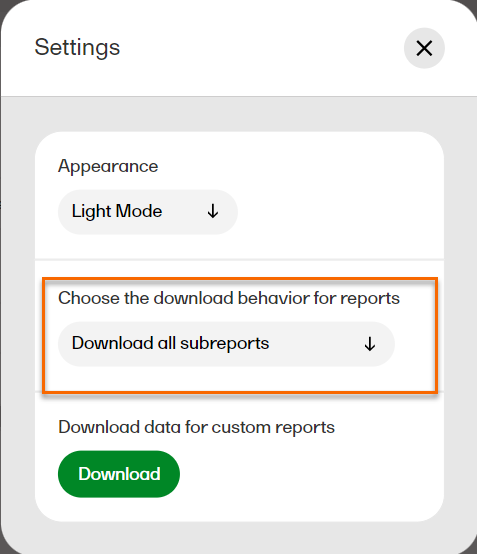
|
|
2. |
1. Select a format to download. 2. Click Download. 
Note! When the formats xlsx/csv/xpt/xptv8 are selected, a zip file is created. The structure of the file name is as follows: [STUDYNAME_REPORTNAME_DATE/TIMESTAMP.zip].
Example of a file name: Demo Study_Recruitment_202203230002854.xlsx
Example of a file name: Demo Study_Recruitment_by Country_20220329230643.rds
|
Note!
- The Key risk indicator report has the download behavior Download selected subreport by default due to user selections available in subreports.
- The Audit trail review report does not have a download feature.
Data sync
There is a possibility that Viedoc Reports will fall out of sync. If Viedoc Reports falls out of sync. We suggest that you take the following steps to reset and reinitiate the sync job.
| 1. | Disable Viedoc Reports in Viedoc Admin/Study settings. |
| 2. | Wait 1 hour. |
| 3. | Enable Viedoc Reports in Viedoc Admin/Study settings. |
The sync will be reset and reinitiated. Your Viedoc Reports should display the correct data. If you continue to encounter an issue please contact your Viedoc representative.
